Photo

On the Other Side, by Shannon Estlund. Courtesy the Kolman & Pryor Gallery
0 notes
Link
0 notes
Text
Observing the water landscape in German-speaking countries

Kristen Anderson
I am a student at the University of Minnesota studying Political Science and Sustainability. In my liberal arts education, I have had plenty of opportunity and flexibility to take courses in environmental policy, urban planning and design, and sustainability in theory and in practice. I have grown especially interested in water issues. I care about the Mississippi riverfront in Minneapolis, the effects of agriculture on water quality, and the connections people have to their drinking water, lakes, and rivers. So when I went to Germany to study, I took a good look at how the places I visited treated water as part of the landscape.
I spent 11 months in Europe, studying abroad and traveling. Because I only visited a handful of places, it’s impossible to make generalizations about “Europe” overall. There are so many histories, so many languages and dialects, so many different cultures. During my two semesters with IES Abroad programs, I lived mostly in Freiburg, Germany. Here are some things I observed about water, organized by increasing scale on the landscape.
DRINKING FOUNTAINS, BUT DIFFERENT
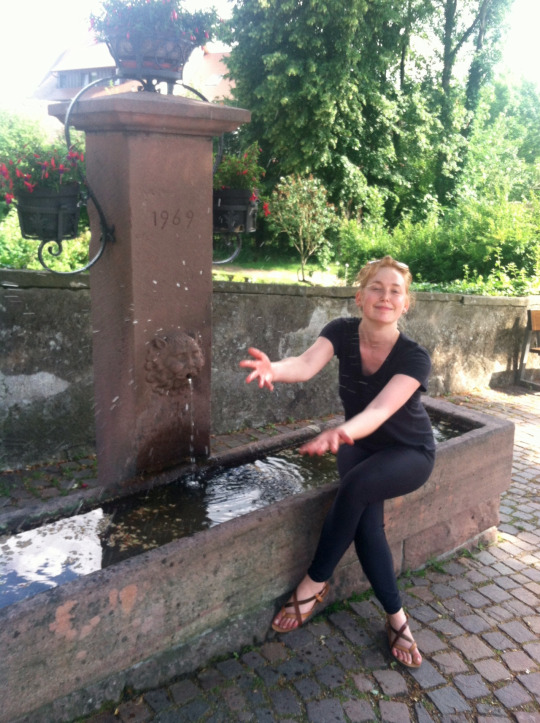
Drinking fountain near Freiburg, Germany.
Drinking fountains with potable water are often found on city streets. Zurich is especially proud of its clean water and beautiful public fountains. Whereas in America we have drinking fountains inside all schools, businesses, and most public buildings, I don’t think I ever saw an American-style drinking fountain inside of a building.

Other fountains are incorporated into historic structures, such as this water fountain and mural tucked under an eave in a historic quarter of Basel. A small sign under the spigot indicates in multiple languages that the water is potable. Generally, fountains are assumed to have clear, drinkable water unless labeled otherwise.
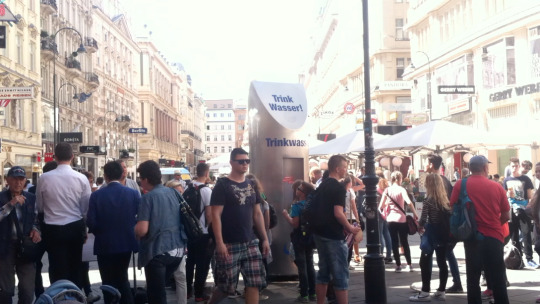
One of 12 drinking fountains in Vienna, Austria, designed for the European Soccer Championships.
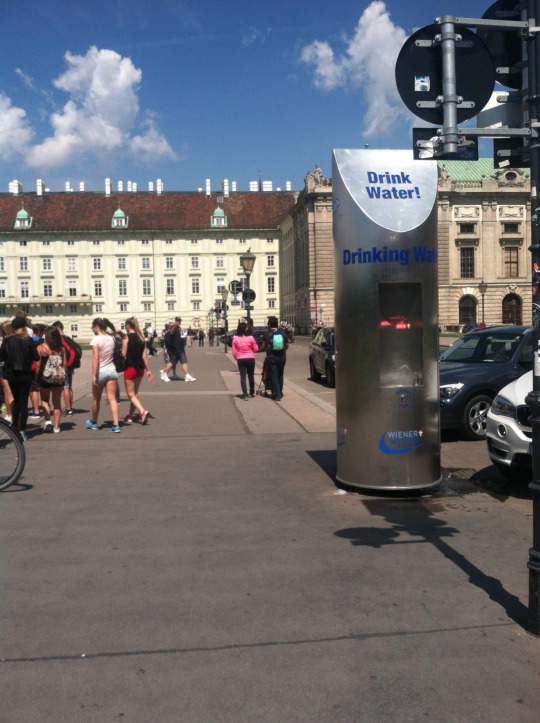
Vienna drinking fountains feature spigots and a mist shower.
In Vienna there is a modern set of drinking fountains. The 12 large stainless steel fountains were designed for the European Soccer Championships to provide refreshment to fans in crowded public places. They have “Drink Water!” written prominently (in German and English) and feature two spigots and a button-operated mist shower. These movable fountains are now set up in the most popular tourist areas of the city to provide free fresh drinking water.
LIVELY URBAN RIVERFRONTS
In Europe, many riverfronts seem to have a lot more people on them, engaged in many more types of activities, than in the U.S. There is nothing wrong with biking and jogging and walking, which is what the American riverfront is used for, but population density in Europe is much higher than in America. There are more people competing for their share of public space and natural resources, and there have been for centuries. Because of the higher density and demands on their environment, Europeans must be innovative in how they design, govern, power, and live in cities. American cities sprawl out with new greenfield developments and separate their commercial, residential, industrial, and recreational uses of land. In contrast, European riverfronts are often multi-modal and multi-use.
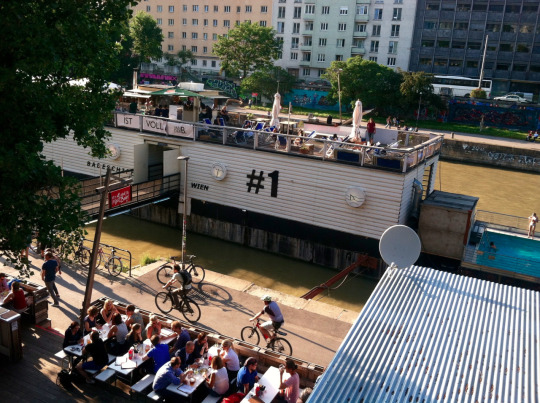
Floating restaurant and swimming pool on the Danube Canal in Vienna, Austria.
An excellent example of a lively riverfront can be found in Vienna on a summer afternoon. The old Danube Canal flows near the historic downtown, while the actual Danube River flows further away. Along the canal there are walking and biking paths, walls of colorful graffiti, cafes with outdoor seating overlooking the scene, and boarding areas for tourist cruises. A floating restaurant occupies half of a barge, and on the other end there is an aqua-blue swimming pool floating above the gray-brown canal water.
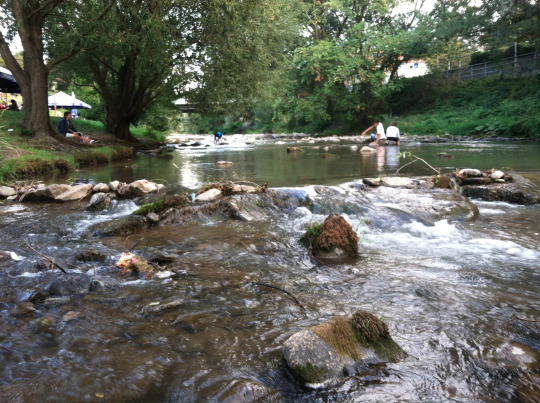
Wading near a streamside cafe in Freiburg, Germany.
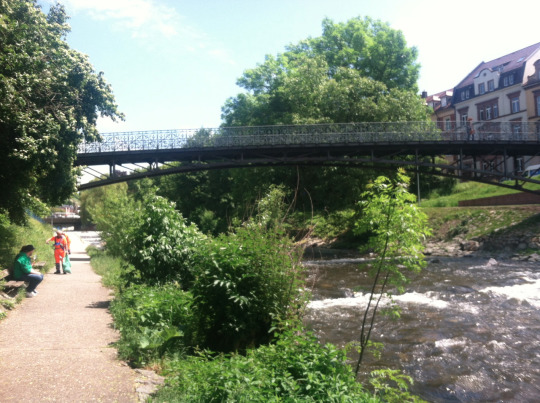
Pedestrian paths and bridges along the urban Dreisam River in Freiburg, Germany.
On a much smaller riverfront, Freiburg has some great spots alongside the small Dreisam River. Five minutes from the central commercial pedestrian zone is a large arterial street and the Dreisam River. Anyone can descend right to the cold, clear water, and the sounds of traffic almost disappear. Then they can enjoy brunch or a beer at a streamside cafe, or wander on the walking path which has plenty of benches. When it’s hot, the river is an alternative to air-conditioning. There are wonderful wading and swimming spots, and highly used picnic areas. Some people even set up their lawn chair and grill right in the middle of the stream.
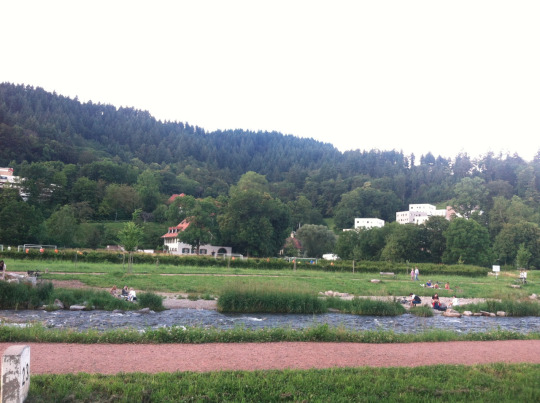
Picnickers enjoy the Dreisam River and the beginning of the Black Forest in Freiburg, Germany.

Express bike route, pedestrian path, Dreisam River and picnic grounds in Freiburg, Germany.
On the other riverbank of the Dreisam, opposite the walking path, there is an express bike route. At the intersections where the bike route meets a road, the bikes have the right of way. This express bike path is part of the city’s Bicycling Concept for 2020, because it gives easy access to important neighborhoods, to the city center, and to other attractions like the stadium located along the river. The riverfront bike path extends several dozen miles. High water levels are monitored by daily public streamflow gauges; the trails are closed or rerouted if seasonal flooding of the trails occurs.

High water levels nearly flood the Dreisam River bike route in Freiburg, Germany.
Extensive networks of bike paths often follow rivers. German-speaking travel companies even offer longer-distance bike tours, with several routes and itineraries. Tourists can cycle leisurely along riverfronts by day, explore cultural gems and enjoy dinner in a restaurant, then find their luggage already delivered to the hotel room. The Danube is a particularly popular destination. These trips also make it easier to tour rivers by offering electric bikes, short daily distances, and transport past rough or difficult areas. In America, organized bike tours are much less common or convenient.
REGIONAL LANDSCAPE INFLUENCED BY RIVERS
Between France and southern Germany is the unique Alsace region. The Rhine River has often served as a natural border. But over many centuries of shifting control, the region also had shifting borders and developed its own language, culture, and river borderland history. It doesn’t really belong to either country. Imagine living in Strasbourg, France, but then the Germans claim the city, and then a couple decades later residents are back to being French! The photo below shows Strasbourg’s charming Petite France area, closer to the river than the city’s central core. The building on the far right is the Tanner’s House, built in 1572. In the walled city of the middle ages, the wall kept out attackers, and also kept out stinky professions like fishermen and leather tanners. These people were closer to river, just like the undesirable industries along riverfronts in many other places of the world. Today, those same waterfronts are entirely desirable for everyday activities and cities have changed their orientation back towards the water.

Tourists and Tanner’s House in the Petite France area of Strasbourg, France.
Beginning in the nineteenth century, the Rhine River was straightened by military general Johann Gottfried Tulla. The massive engineering feat was intended to reduce the catastrophic results of natural flooding, but the deepened channel also lowered the groundwater level and changed the floodplain ecosystems.

American students on study abroad walk past a sign indicating historic flooding levels prior to channelization of the Rhine River in Istein, Germany.
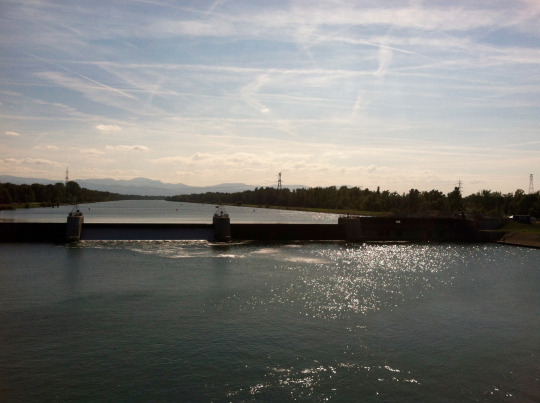
Weir dam and lock on the Rhine River at Breisach, Germany.
Additional canalization in the Upper Rhine Valley is seen in the extensive Grand Canal of Alsace. It has several locks and dams and allows for navigation to Basel, Switzerland. This is a very important European inland waterway. The French won exclusive hydropower rights in the 1919 Treaty of Versailles (which brought an end to World War I). Parallel to the hardscaped canal flows a wild channel, which can take on seasonal extra flow diverted from the canal.

Bottom to top: Rhine Canal, navigation channel, and hydroelectric plant at Breisach, Germany. Wikimedia photo.

“Natural” Rhine River channel allowed to flood near Hartheim, Germany.
The Integrated Rhine Programme proposes floodplain restoration through a series of polder projects to reclaim land via dikes and drainage systems. It was developed by the French and German governments through an agreement signed in 1982 to increase flood protection and riparian wildlife habitat. https://www.youtube.com/watch?v=trPhVP8N6ng The polder at Altenheim is a working example. Dikes surround an area of alluvial forest, which is flooded when a gate is opened. Then the water slowly drains back out to the main channel of the Rhine River. Downstream communities benefit from mitigated river flow.

Citizen activists oppose a flood management project with this billboard on the proposed site near Hartheim, Germany.
Of the proposed projects necessary for full implementation of flood regulation on the Rhine, some have encountered resistance. At a project near Hartheim, for example, local citizens put up a billboard to express their concerns about increased truck traffic through their town and destruction of forest. A nearby project involved the removal of thousands of truckloads of gravel, which allowed the river to flood into the gravel pit area. Despite the local frustrations, within two years there was successful regrowth of the willow-poplar alluvial forest. Other projects have yet to be completed.

Students learn about a successful new flood mitigation forest several miles from another project facing opposition at Hartheim, Germany.
CONCLUDING THOUGHTS
I saw and experienced these examples of connections to water through the lens of my liberal arts education and my interest in water resources and urban planning. It is impossible to generalize attitudes about water that would take into account a whole continent of people from various cultures, so it would not be fair to say that my observations proved that water was more intentionally cared for by Europeans. However, I do believe that the Germans, Swiss, and Austrians have a certain consciousness about the value of their natural resources. Maybe it is ingrained in their society because of centuries-long interactions with fields and forests, stunning wild Alpine landscapes, and natural water features.
This valuing of resources is evident in Germany’s comprehensive recycling programs, and in a German company’s commitment to developing water-efficient appliances. It makes sense that Germany leads the European Union in organic agriculture standards that protect land and water, and that Austria and Switzerland utilize their mountainous geography and high annual precipitation to generate 60 percent of their energy using responsible hydropower.
As I conclude my undergraduate studies and continue my professional development, I will look at the familiar Minnesota landscapes and waterways a little differently. I will see the smallest fountains as connected to the largest river networks. Every individual behavior is part of a complex, interconnected system, and all the elements add up to create a culture around water. I enjoyed taking thousands of pictures during my travels, learning about the background and potential of these examples, and sharing my knowledge with this reflection. I have gained a new perspective on how the communities I visited treat water as a valued part of the landscape.
0 notes
Link
“Thousands of acres of environmentally sensitive land in southwest Minnesota will be converted to native plants and grasses in an ambitious effort to protect local waters from polluted runoff, thanks to a major new infusion of cash for rural conservation.
A highly anticipated state-federal deal, announced Tuesday by Gov. Mark Dayton, will provide $350 million from the U.S. Department of Agriculture and $150 million in state funds to the Conservation Reserve Enhancement Program (CREP) which pays farmers to idle vulnerable land near lakes, streams and rivers.”

- Source
0 notes
Quote
Living between two worlds is uncomfortable. And hard. And sometimes it’s tempting to crash into one of these worlds, instead of having a foot in both. It would be so easy to abandon ourselves in a world of despair and frustration, hating everything and everyone, and turning our backs on the world. How indulgent and self-satisfying! But it’s the wildly selfish choice, and doesn’t help anyone. And it is so tempting to ignore the problems of our time, turn off our minds and hearts, and live in a fantasy, fueled by an orgy of entertainment, shopping, recreational drugs, or other mindless pursuits. That’s where many people escaped. I can hardly blame them. But, for me, the best place is to be exactly in the middle: to feel both the hope and the anguish, the joy and the suffering, of our moment of history. We need both to fuel us, steer us, and keep our paths true. It’s as if we need the gravitational pull of both worlds to keep us on track, locked on a good and righteous path. Without both worlds pulling on us, we would crash into one, or simply lose our way, hurtling through the universe on our own, intersecting nothing, helping no one.
Jon Foley, “The Space Between Two Worlds”, The Macrosope
“If you’re awake and alive in the 21st century, with even an ounce of empathy, your heart and mind are going to be torn asunder. I’m sorry about that, but it’s unavoidable — unless you simply shut down and turn your back on the world. For me, the only solution is found in the space between awe and anguish, and between joy and despair. There, in the tension between two worlds, lies the place we just might find ourselves and our life’s work.”
0 notes
Photo





Friends of the Mississippi River @ Fair State Brewing Cooperative
October 2016
LINK to Event
With a pint of delicious locally-brewed Hefeweizen beer, I joined the company of several interested River Citizens. We learned from FMR Watershed Program Director Trevor Russell and Water Quality Coordinator Lark Weller of our local unit of the National Park Service.
The topic was the health of our urban 72 miles of Mississippi River. The State of the River Report uses current research and expertise to tell the public about swimmability, fishability, environmental indicators, wildlife, and more! Humans are having a big impact on the Mississippi River. One category I found especially interesting was sediment from upstream farmers, indirectly polluting the water. The presentation at Fair State in October 2016 elaborated on 1) Hydrology and river flow, 2) Pollution such as e coli impairment, 3) Nitrate proliferation in drainage from fertilizers, and 4) Microplastics.
The State of the River is a unique project of advocacy nonprofit Friends of the Mississippi and the National Park Service. It is a critical source of reliable information, and sets a precedent for tracking the river indicators that we value the most.
#Mississippi River#Friends of the Mississippi River#brewing#national parks#State of the River#Mississippi River Corridor Critical Area
0 notes
Photo

Artwork by Ali Mahad, Macalester College '18, watercolor and ink on paper.
1 note
·
View note
Photo

'State of the River' at Fair State Brewing Co-op
from the FMR website:
Event Date: Monday, October 3, 2016 - 6:00pm to 8:00pm Location: Fair State Brewing Cooperative, Minneapolis
“How is the health of the Mississippi River? Can I safely swim in it? Can I eat the fish I catch? What can we do about silver and other invasive carp? How are bald eagles faring?
At FMR we hear questions like these all the time. That's why we partnered with the National Park Service's Mississippi National River & Recreation Area unit to develop the State of the River Report(recently updated for 2016).
Join FMR Watershed Program Director Trevor Russell and Water Quality Coordinator Lark Weller of our local unit of the National Park Service at Fair State Brewing Cooperative for a brief overview of the report's key findings. From invasive "flying" carp to bacterial contamination, from eagles to swimmability, Trevor will spend the first portion of the evening highlighting the most important trends and emerging issues as well as potential solutions. Next, we'll have an informal Q & A session then enjoy a brewery tour and free growler raffle! To make sure everyone has a chance to ask questions, and due to limited seating, capacity is limited and advance registration required. However, the brewery will be open to the public during the presentation.
This event is part of Brewing Clean Water, bringing FMR and local breweries together. All participants will be invited to future FMR-brewery and educational events.”
An Evening Celebrating the Mississippi River 2016
Event Date: Tuesday, October 4, 2016 - 5:30pm to 8:30pm Location: Nicollet Island Pavilion, Minneapolis
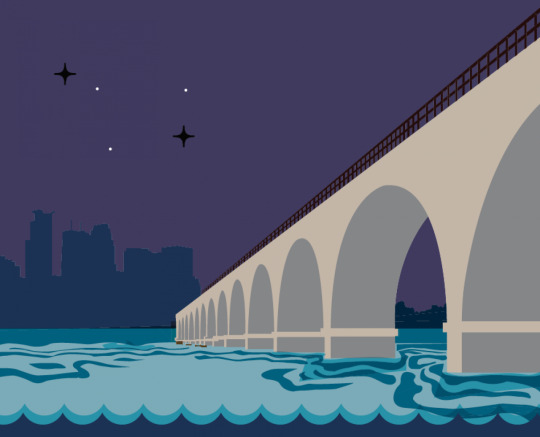
“Join us for the Big River's biggest night, Tuesday, October 4, 5:30-8:30 pm.
Join us to celebrate the Mississippi in the midst of its fall splendor. From our beautiful venue on the river, we'll toast to you and the recent successes you made possible. The evening will feature:
Keynote speaker Tim Palmer, an award-winning photographer, conservationist and author of 26 books about rivers, who will share tales of his adventures exploring America’s magnificent waterways and discuss current river conservation and restoration issues important to us all
The Water Bar — a public art project that serves local tap water to highlight pressing local water issues
An entertaining river-themed live auction
Hearty hors d'oeuvres and drinks
Live music
Tickets
Please consider a minimum $100 contribution for each attendee. Funds raised through this event conserve the Mississippi River and its watershed in the Twin Cities region.
If you can't join us, but would like to support the event and FMR, click here.
A special thank you to our generous event sponsors.
Individual Sponsors
Bald Eagle
Sharon & Terry Avent • Susan & Joel Barker • Susan Boren & Steve King • Ronnie & Roger Brooks • Ellen Butler & Harlen Hegdal • Jay & Page Cowles • Stewart & Lesley Crosby • Chad & Maggie Dayton • Edward & Sherry Ann Dayton • Judson Dayton & Shelley Mydra-Dayton • Friends of Nicollet Island • Dan Gjelten & Lisa Burke • Peter & Mary Gove • Bud & Carol Hayden • Diane & John Herman • Chris & Julie Higgins • Diane & Tony Hofstede • Shotsy & Ward Johnson • Art & Martha Kaemmer • Julia Kaemmer • Katherine & Darrell Majkrzak • Ryan & Denise Mallery • Perry McGowan & Sheila Smith • Hokan & Penny Miller • Bill Newman • Ford & Catherine Nicholson • Kate & Stuart Nielsen • Amy & Chip Pearson • Susan Davis Price • Tom Reiter & Sharon Miyamoto • Paul & Mary Reyelts • Diane & Darryl Sannes • John & Marsha Soucheray • Karen Sternal & Lowell Pickett • Susan Vento • Joanne Von Blon • Deanna Wiener & Jim Tilsen • Kate Wolford & Ed Reilly
Blue Heron
Mary Adamski & Lance Ihinger • John Anfinson • Marcia Avner & Wy Spano • John & Mary Beattie • Ellen & Peter Brown • Whitney & Sarah Clark • Ellie Crosby • David Durenberger & Susan Foote • Jeff & Linda Evans • Forrest & Lisa Flint • Peter Goss & Karma Walker • Kit & Bill Prendergast • Mike & Gretchen Sieben, Katie Sieben & Josh Straka • Kathy Stack • Mark Thomas, M.D. • Cynthia Whiteford & David Nelson • Phil Willkie • Della & Will Young
River Otter
Joe Bagnoli & Barbara Cox • Candace Campbell & Jerry Seck • Chuck Dayton & Sara Evans • Sara & Sean DeKok • George Dunn & Donna Harris • Jeff & Lucy Heegaard • Jeanine & Zach Holden • Louise Jones • Sam & Sylvia Kaplan • John Kaul & Gloria Gunville • Tom & Marlene Kayser • Miriam & Erwin Kelen • Ron Kroese & Kimberly Colburn • Ross & Bridget Levin Charitable Gift Fund of The Minneapolis Foundation • Lynn & Tim Moratzka • Chris Mortenson & Nathalie Salas Gonzalez • Ed & Charty Oliver • Jose Peris & Diana Gulden • Phil Riveness • Becky Rom & Reid Carron • Harry & Ginny Sieben • Katie Simon-Dastych & Jerry Dastych • Karen & Nate Solas • Katherine & Jeffrey Tane • Bob & Sandy Tilsen • Bill Tilton • Cathy Tobias • Scott Vreeland & Lori Bergstrom • Sara & Doug Wolff
Corporate Sponsors
Ascent Private Capital Management of U.S. Bank • BMO Harris Bank • BWBR • Live Green, Live Smart Builders • Minnesota Native Landscapes
Questions? Contact John Briel at 651-222-2193 x19 or [email protected].”
0 notes
Photo

Book Review: The Wallcreeper
This environmental novel is sharp and strange and suspiciously unethical. From the perspective of a shameless housewife, life lacks meaning. She realizes that she thrives on having affairs and committing eco-sabotage. The book’s voice is quick and intriguing.
Why do I post it on this blog? A central plot revolves around rivers. Characters Tiffany and Stephen get involved with birdwatching and environmental protection and alternatives to hydropower, and they eventually work for an advocacy organization called ‘Global Rivers Alliance’.
The couple focuses on the Rhine River, attempting to gather support and lobbying to blow up dams and canals. They use the campaign slogan Wasserkraft Nein Danke. However, a Rhine floodplain restoration would never be politically or institutionally possible. Tiffany then works on a smaller scale. On an isolated spot of the Elbe River, she manually removes a levee structure and floods a protected forest, in the hopes of restoring bird habitat. Pretty radical.
Among other absurd plot developments, blatant conversations, and subversive musing from Tiffany, The Wallcreeper explores truths about life, love, culture, and the values we place on nature.
1 note
·
View note
Text
RIVER SEMESTER
Offered by Augsburg College (SOURCE LINK)
“A UNIQUE, LIFE-CHANGING, EDUCATIONAL EXPERIENCE.
travel the length of the Mississippi River from Minneapolis to New Orleans by canoe, bus, boat, and train
develop a field research project on topics such as water pollution, the Clean Water Act, agriculture in the watershed, political organizing around environmental issues, race relations and social justice, or urban riverfront revitalization
explore the history, literature, food, music, and culture of the Mississippi River from the headwaters to the Delta
gain skills tailored to fit the needs of partner businesses and institutions including graduate schools, nonprofits, and government agencies
meet with local experts, “river rats,” and environmental organizations along the river
hear from guest lecturers on Twain and Faulkner, ancient river civilizations, American Indian communities and their fight for justice, and the Dead Zone in the Gulf of Mexico
Program partners include Wilderness Inquiry, the Wild River Academy,Quapaw Outfitters, Louisiana Marine Consortium, Mississippi National River and Recreation Area, Friends of the Mississippi River, America’s Waterway, Augustana College (Rock Island, IL), the University of Minnesota’s River Life Program, and Works Progress.
Check out the River Semester Prezi.
Blog post on why we have a river semester.”
2 notes
·
View notes
Link
Click the link above for full article. There was recently a River Balcony Prototyping Festival! I was intrigued by the title, but did not attend.
“Downtown Saint Paul’s location on the Mississippi River provides a unique opportunity to create a strong link between the city and the river. The City's Great River Passage Master Plan calls for a River Balcony along the downtown river bluff from the Science Museum of Minnesota to the Union Depot.” (Source: City of St. Paul)
0 notes
Photo







Lake Kitsch
Decor at Grandpa Anderson’s cabin in Spirit Lake, Iowa.
0 notes
Quote
And I screamed, and I'm sure all of Lake Harriet heard me.
“Victim says she had to pry fox's mouth to free herself.” Source: Kare 11 Video
A newsworthy conflict between humans and nature played out on the banks of Lake Harriet. It’s a popular spot for walkers, cyclists, swimmers... and wildlife! That includes a fox that bit two lake-goers recently. It was captured, put down, and confirmed as having been rabid.
0 notes
Text
Water in the News | Small Town Edition
“Canoeist rescued from Cannon River” : A tipped canoe and some local rescue teams
“Exploring the naming of the scarlet city” : Red Wing on the Mississippi named for Dakota chief who carried a symbolic red swan’s wing, one of many birds found in the river valley
“Art, science both examine concepts of truth, value” : Artist gives presentation Bluff & River: Where Art & Science Meet, grounded in observation of the natural world
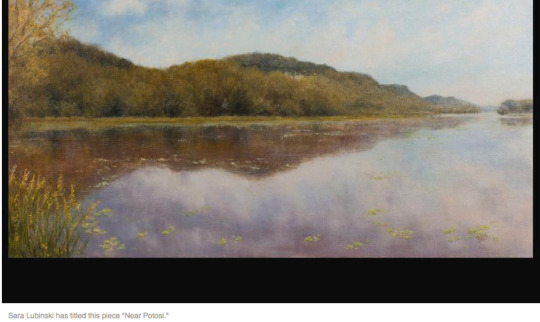
0 notes
Quote
As the summer goes on, it gets worse. It looks like you could walk on it.
Dave Nelson, private pilot volunteering for NASA

Water in the News | “NASA's eye in the sky monitors algae blooms on the Mississippi River”
The water of the Mississippi below Lake Pepin made the front page of the newspaper. A group of pilots and a researcher are monitoring toxic algae blooms through aerial photography.
Source: Star Tribune
0 notes
Photo

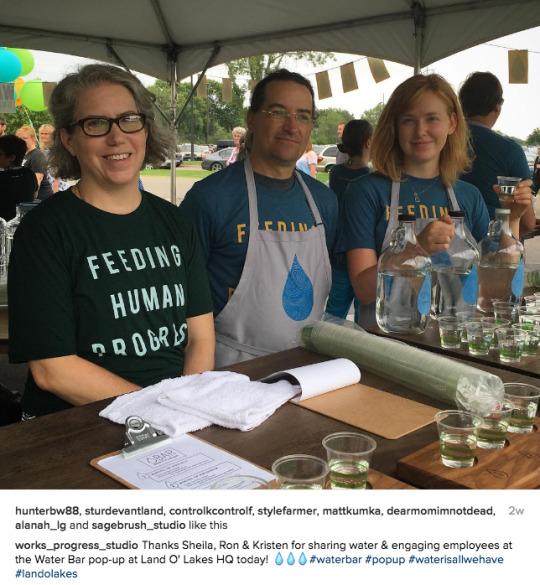
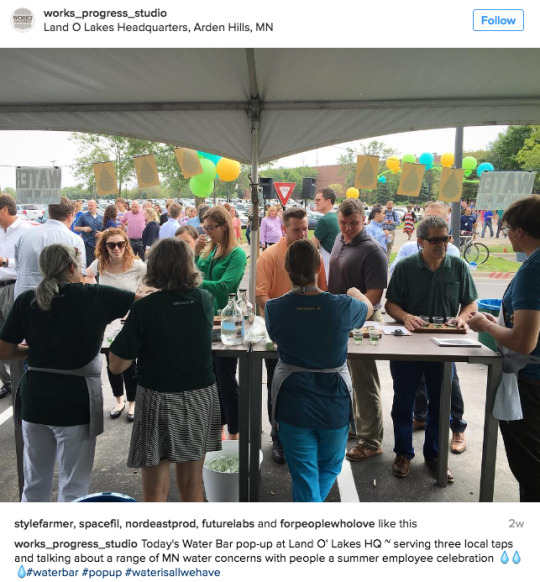
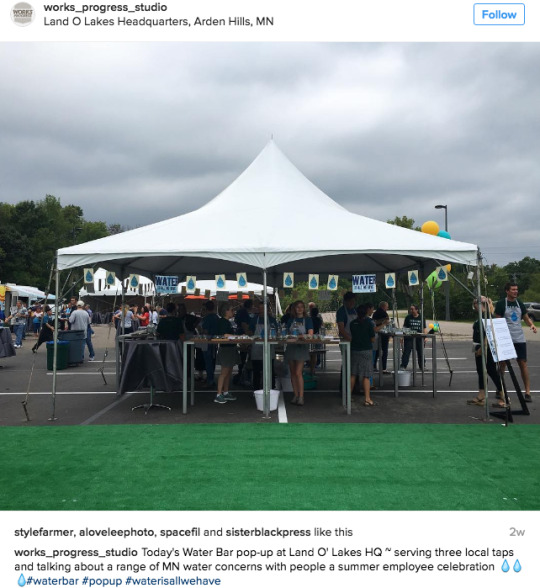

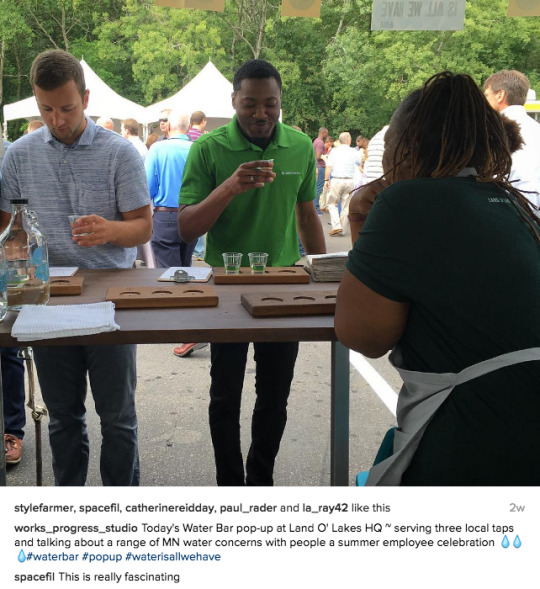
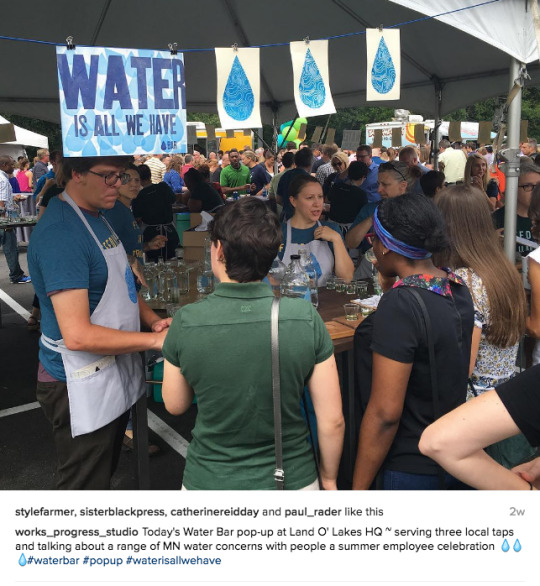
Water Bar at Land O’Lakes
The drinks flowed freely at this employee celebration...to be more specific, the flowing water from Water Bar!
Never heard of Water Bar? This project offers samples of local drinking waters. It is a traveling “pop up” installation and has a new permanent space in Northeast Minneapolis. Anyone can walk up to the bar and taste a flight of waters, each with a story.
Water is all we have... it’s a tagline that can sound silly at first. Some people chug their waters, shrug their shoulders, and walk away unable to taste any differences between the waters. For example, there are different ‘flavors’ of water pumped from a well, or pumped from the Mississippi and then treated.
Some visitors begin to realize the significance of that tap water, aided by ‘Water Bar Tenders’. They are scientists, artists, students, and community members. They stand by, ready to serve the water and ready to start conversations. The atmosphere is relaxed like in a regular bar setting. A dialogue about water quality, conservation, or culture can be the result!
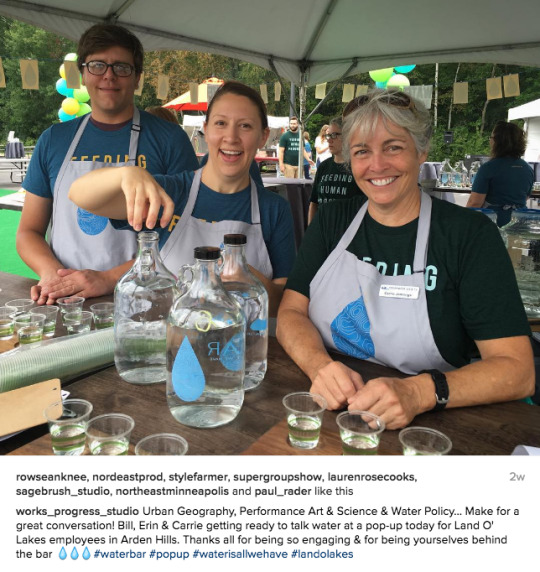
On Tuesday, August 9th, the Water Bar was open at a private event at Land O’Lakes corporate headquarters. But what’s in a name?

There’s more than you think behind the label of their top-selling butter, which originates from the Land of 10,000 Lakes. As a Fortune 500 company, Land O’Lakes is a multi-branched agricultural cooperative. There are thousands of cows and farmers behind the butter production. There are vast quantities of feed and farmland behind those cows and farmers.
Land O’Lakes Inc. is behind it all. That business includes dairy products, foodservice supply, and pet food. However, the largest area of the corporation deals with farming innovations. The WinField brand offers agricultural inputs (seeds and sprays and fertilizers) and technological insights “to help farmers be both good stewards and successful producers.” They supply 300 Minnesota ag retailers reaching 25,000 farms.
That’s a big potential impact, especially because agricultural practices have the biggest influence on water quality in Minnesota.
In the “Responsible Acre” interactive webpage, you can learn how WinField works to optimize use of our precious freshwater supplies. Data-aided methods improve irrigation. Super-sticky ‘adjuvant’ sprays ensure each drop hits its crop target. No-till field maintenance reduces erosion of sediment and nutrients into waterways.

What’s the future conservation impact of Land O’Lakes coop farms? A recent partnership will encourage Land O’Lakes members to join the Minnesota Agricultural Water Quality Certification Program. A farm must check off all its conservation boxes, complying with current MN environmental policies. Then the MN Dept of Ag program provides regulatory certainty to that farm for the next 10 years, no matter what new laws may come into effect. It’s like they’ll be grandfathered in at the current level of environmental protection. Plus the farm will receive recognition and priority for technical assistance. (More: Star Trib article “Land O'Lakes, Minnesota partner on water quality initiative”)

With more farmers participating and expanding the MN Ag Water Quality Certification Program, a big company like Land O’Lakes can make tangible and steady improvements to clean water across the state.
Water Bar Menu, Aug. 9th, 2016:
Arden Hills Tap Water. Sourced from the Mississippi and supplied by St. Paul Regional Water Services. A complex, state-of-the-art water treatment system gives this water a comparatively ‘chemical’ taste, according to many Water Bar guests. St. Paul Regional Water Services supplies 50 million gallons a day to 415,000 customers through 1,100 miles of water mains. (More: Fox9 article "Praise for St. Paul water, as charges come down in Flint water crisis")
New Brighton Tap Water. This community recently switched from independently-pumped groundwater to Minneapolis-supplied water. In the New Brighton water, there was a contaminant detected and traced back to a local Superfund site. (More: Star Trib article "Two north metro cities scramble to upgrade water plants to filter out emerging contaminant")
Schmidt Organic Water. Always a Water Bar 'peoples’ choice’ favorite! This water made great beer 150 years ago. Its deep aquifer captured the water 30,000 years ago. At the St. Paul location, you can buy this artisan water for $1 or $1.50 a gallon. (More: Facebook page “Schmidt Organic Water”; Star Trib article "Schmidt Brewery to sell pristine spring water")
One significant interaction occurred when a man cheerfully approached, tasted the three waters, and then shook his head. He works as an environmental quality controller for Land O’Lakes. He knows that even compliant wastewater treatment measures might not be good enough. He has a reverse osmosis system at home, which can be expensive. He said he doesn’t want his kids to drink tap water. I can’t remember where he said he lived, but if experts like him see a problem with public water quality, then what can the rest of us lowly uninformed water-drinkers do about it?

On a personal note, my mom hasn’t been drinking tap water either. She is building her dream kitchen (mid-life crisis?), and we haven’t had a kitchen sink for a month. We do dishes in the bathtub.
She says she doesn’t like the taste or texture of the softened water from the bathrooms, so she refills gallon jugs at the grocery store. That got me wondering, is there any health risk to drinking water laden with softener salt? Is it okay to drink it for a short period of time? When did ‘softened water’ become a household fixture?
These are questions to be investigated further.
Click HERE & share your answers to some watery questions!
That lovely #WaterIsAllWeHave print was obtained when I water-tended, and more are available. Check out Works Progress Studio on Instagram.
#WaterBar#WaterIsAllWeHave#clean water#water quality#Water in the News#conservation#Environmental Policy#Mississippi River#drinking water#WorksProgress#Land O Lakes
0 notes
